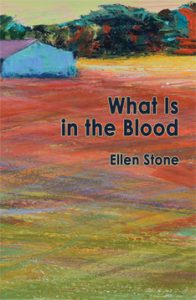 Review by Christina Veladota
Review by Christina Veladota
Ellen Stone’s poetry is beautiful and is distressing in its beauty. Winner of the 2013 Michigan Writers Cooperative Press Chapbook Contest for The Solid Living World, Stone has a prolific publishing history in literary journals and has been nominated many times for the Pushcart Prize and Best of the Net. Accolades aside, the power of Stone’s work is evident in her stunning imagery.
In her new poetry collection, What Is in the Blood, the musicality of her lines evokes the strong emotional tether that keeps the speaker rooted in her childhood, even as she speaks to us as her adult self. The speaker in What Is in the Blood reveals a life informed by a mother who suffers from bipolar disorder and whose illness is an unsettling force in her life.
The book is divided into two sections; the first maintains a focus on childhood and young adulthood, when the mother’s illness and frequent absence transforms her into a ghostly figure. The mother is physically absent in many of these first poems, but her presence is a heavy one, is deeply felt. “When you tell me Mom is in bed,” the speaker states in “Summer, 1972,” “the words are sticky and cave in / around me like the cracks / on the asphalt road in late July” (15). The speaker seems to comprehend that her childhood is fraught with trauma. She goes on to say,
But I am going to drown there –
all molasses and sink-mud,
I feel it in my marrow, this
losing grip on the morning.
What bird trill moment I thought
we were promised – the open door,
haze above the cornfield rows. (15)
Stone masterfully shrouds pain in the bucolic scenery of farm life, a kind of nostalgia that cannot hide the darkness. There an open door, but she cannot walk through it.
In the second section of What Is in the Blood, the speaker has become an adult, who possesses a clearer understanding of her mother’s struggles with mental health. This understanding does not ease the burden, however. In “Walking to Topsfield,” her mother believes she is called by Jesus to walk, morning to night, “Forty miles from Boston,” to deliver his message. “What shape her feet were in,” the speaker tells us, but “She did not want to talk about it, except to say / she ended up back at Mass General” (41).
The mother is in and out of the hospital, not just for her bipolar disorder, but also due to a kidney transplant. In the poem, “Good Friday in the transplant clinic,” the speaker sits with her mother, who waits to have her blood drawn. She tells us, “Almost spritely, Mom glows, her new life with a child’s kidney” (43). The knowledge that the organ donor is a child hangs heavily over the speaker. Though she must know that her mother is not responsible for this child’s death, she seems to want her mother to acknowledge this life lost so young. She states,
The lines are long.
My arms feel hollow.
I want to call out to her –
little girl who saved my mother.
Find a flight to Oklahoma
to guide the living
through their long walk.
My mother’s blood courses,
looping gently through
her circular riverbed of veins.
I sit nearby, waiting,
watching for any sign
of redemption. (43)
This moment is devastating. If her mother cannot feel anything for this child’s death, she may never recognize that the speaker, long ago, lost her own childhood to this very woman.
In What Is in the Blood, Stone doesn’t waver from revealing the truth about what it means to experience and survive a traumatic childhood. Her language is beautifully wrought. In an interview with the poet, published by Orange Quarterly in February of 2019, Stone says, “Poetry is my means of prayer.” Ellen Stone’s prayers are palpable throughout this superb collection as the speaker seeks a form of redemption that we hope she eventually finds.
What Is in the Blood, by Ellen Stone
Mayapple Press, 2020, $17.95 (paper)
ISBN: 9781936419951
The author of two poetry chapbooks, Clutch & Brood (Aldrich Press, 2016) and The Girl & Her Lions (Finishing Line Press, 2010), Christina Veladota is a recipient of a 2020 Individual Excellence Award from the Ohio Arts Council and was named a finalist for a 2020 Sustainable Arts Foundation grant.
